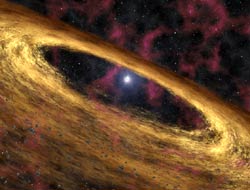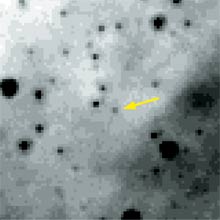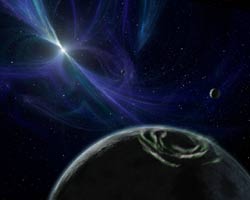
Astronomer-artist Robert Hurt depicts the disk around the neutron star 4U 0142+61. The disk contains about 10 Earth masses of material and orbits very close to the star. Click on the image for a larger view.
Courtesy NASA / JPL / Caltech / R. Hurt (SSC).
For many years astronomers have theorized that when massive stars explode as supernovae, some of the material won't be ejected with enough speed to escape the system. This material falls back and will either crash into the dying star or form a disk around it.
Now, thanks to NASA's Spitzer Space Telescope, scientists have their first observational evidence that a supernova fallback process occurs in nature. MIT astronomers Zhongxiang Wang, Deepto Chakrabarty, and David Kaplan used Spitzer to find the thermal glow of a dusty disk around a neutron star — the dense, compact remnant of an exploded star. Given the neutron star's estimated age and the expected lifetime of the disk, odds are good that the disk represents the supernova fallback debris long predicted by theory, the team reports in the April 6th Nature. It's conceivable that one or more small planets are forming inside the disk.
Based on the dust's 425° to 925° C (800° to 1,700° F) temperature and its infrared brightness, the MIT team estimates that the disk contains about 10 Earth masses of material, and extends from about 1.6 million kilometers (1 million miles) to 5 million km from the neutron star, which is known as 4U 0142+61 for its sky coordinates in Cassiopeia. Such a disk would fit well inside the orbit of Mercury in our solar system. The host star itself is a magnetar, a neutron star with an extraordinarily powerful magnetic field.

This Spitzer Space Telescope image, taken at an infrared wavelength of 8 microns, shows the magnetar 4U 0142+61 (arrowed). An excess of infrared emission indicates the presence of a dusty disk around the object.
Courtesy Z. Wang, D. Chakrabarty, and D. Kaplan.
"This debris disk result is significant because it provides a proof of concept that neutron stars can have a fallback disk," says Paul Kalas (University of California, Berkeley), an expert in circumstellar disks. "Planets may form in this disk, and they may have exotic properties."
"We don't know how widespread the phenomenon of debris disks around neutron stars is going to be, since it's the first one we found," adds Chakrabarty. "It's possible they are common around young neutron stars. But it's also possible that whatever is special about the formation of magnetars relates to fallback in a disk, so we will test that idea by looking for disks around young magnetars and young neutron stars."
Based on the rate at which the magnetar's spin is slowing, astronomers estimate its age at 100,000 years. This is much shorter than the disk's predicted 1-million-year lifetime, indicating that the disk material dates back to the supernova that produced the magnetar.
The discovery of this disk is significant because the fallback process could play an important role in supernovae. In some cases, enough material crashing onto a neutron star could push it over the edge, forcing it to collapse gravitationally into a black hole. Such a process might have occurred in Supernova 1987A, since astronomers have yet to find any clear-cut signs of a neutron star at the center of the expanding remnant.

Nobody really knows what the pulsar planet system would look like if viewed up close, but Robert Hurt conveys a plausible impression. Three terrestrial-mass planets orbit the pulsar B1257+12 at close range; an asteroid-mass object (not pictured here) orbits much farther out. Click on the image for a larger view.
Courtesy NASA / JPL / Caltech / R. Hurt (SSC).
The disk also provides another potential environment for planet formation. Chakrabarty stresses that no planets have been found in the disk, but the disk's distance range from the magnetar is similar to the distances of three planets found in the early 1990s around another neutron star, the pulsar B1257+12. The total mass of the pulsar's planets is also similar to the mass of the magnetar's disk.
But there are several important differences in the two systems. Although the pulsar planets almost certainly originated in a disk, that disk probably resulted from the destruction of a companion star — a process that spun up B1257+12 to a speed of several hundred rotations per second. In contrast, 4U 0142+61 spins once every 8.7 seconds. "The most direct connection we can make between our work and the pulsar planets is that our discovery shows it's possible for debris disks to survive in an environment around a pulsar," says Chakrabarty.
In a paper posted today on the Internet site Astro-ph, Geoff Bryden (NASA/Jet Propulsion Laboratory) and seven colleagues report on a deep Spitzer search for dust around pulsar B1257+12. Unfortunately, the team found no sign of a disk, but it says that the observations cannot rule out either a very thin disk or an asteroid belt.
 0
0
Comments
You must be logged in to post a comment.